China is the fastest-growing market for live-streaming marketing. The live-streaming industry has been an integral part of China’s digital ecosystem for years, but it will soon become standard practice as Chinese internet users move away from traditional media to focus on live video. This blog post will explore why this is happening and how it can be leveraged to increase your business success.
Overview of China’s live-streaming industry
In recent years, especially since the outbreak of the Covid-19 pandemic, live-streaming and e-commerce live-streaming are becoming one of the most popular ways of promoting brands and selling products online. Chinese live-streamers and live-streaming hosts (sometimes it’s a company, not just key opinion leaders) are becoming internet celebrities on streaming and social media platforms.
Need a cost effective TP (Tmall Partner) to sell in China?
We are an Official Tmall Partner e-commerce Agency. Our Services: E-Commerce, Search Engine Optimization, Advertising, Weibo, WeChat, WeChat Store & PR.
As of 2023, the population of live streaming services has exceeded 660 million, which makes up almost 45% of Chinese netizens. By the end of 2023, 930 million people watched short videos and 700 million Internet users watched live broadcasts.
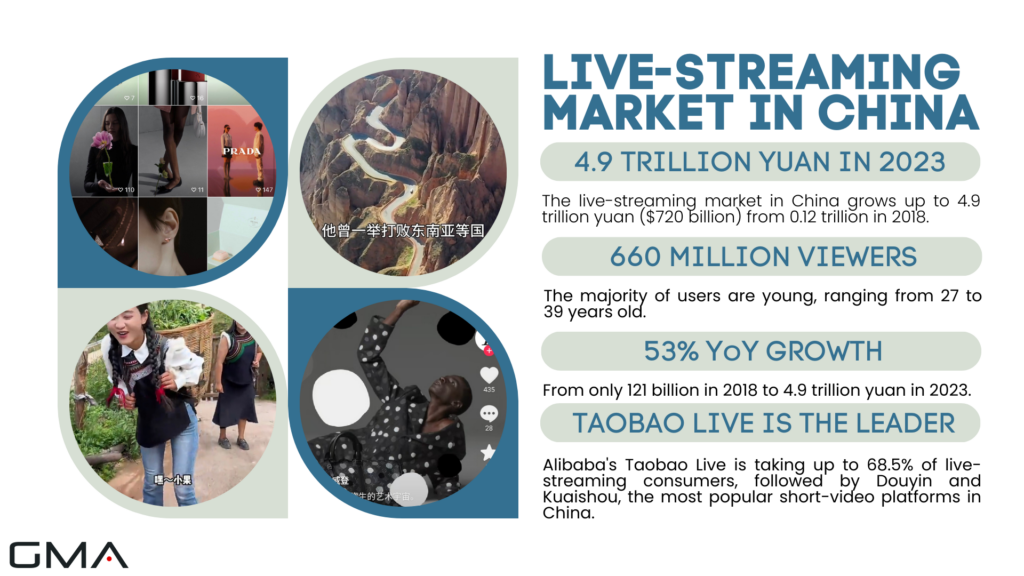
The industry reached 4.9 trillion yuan ($720 billion) in 2023, recording a 53% year-on-year growth from only 121 billion yuan in 2018. It’s almost 12% of total e-commerce sales in the country, and the industry is expected to grow even more.
Covid-19 accelerated the adoption of live-streaming
Until two years ago many still considered live streaming as something futuristic. Despite its undeniable success in China, it was not the first tool on which brands aimed for their digital marketing campaigns. Then, however, the emergency came from Coronavirus. With the increase of time spent at home, often in front of the smartphone or laptop screen, live streaming has begun to be increasingly exploited.
The number of Chinese producers who started live-streaming sessions on Chinese live-streaming platforms such as Douyin, Wei ya, Taobao Live, and Kuaishou, increased by 50% during the quarantine period. Live streams became a new norm, and hundreds of millions of young people started engaging in live-streaming e-commerce, where they were attracted by special offers and virtual gifts.
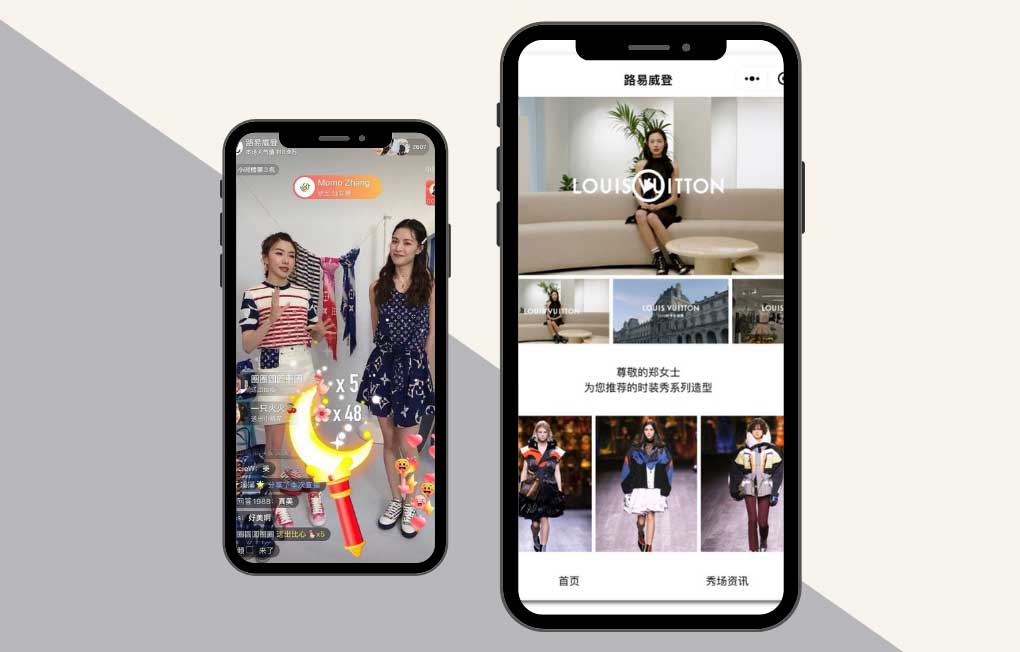
People couldn’t go out to shop, and as they were bored at home, they started to play games and interact with the home shopping network, receiving virtual gifts and purchasing daily necessities, clothes, beauty products, or foreign products in their leisure time.
What does live streaming actually mean?
Live streaming refers to the recording and real-time transmission of audio and video content to a spectator. The live streaming platforms were born in China in connection with the gaming industry, but then they expanded to many other fields. These include entertainment, cooking, information, and shopping.
The live-streaming hosts can be KOLs (Key Opinion Leaders), KOCs (Key Opinion Consumers), professional live streamers, or even simple users. KOLs are Chinese web celebrities, while KOCs are those consumers who have great proximity to their social media followers and greater engagement with them than KOLs.
The contents treated can be the most varied: from how to combine an Italian wine with a typical Chinese dish to the handcrafted qualities of the furniture. The most popular live streams are those showing products in use, like different lipsticks (one of the most popular live streamers, Austin Li, is called the Lipstick King because he became known for showing lipsticks on live streams).

Why Brands Should Collaborate with Live Streamers?
Live-streaming is a unique way to communicate effectively with your audience and consolidate brand awareness. In this particular historical moment, live streaming can prove to be the winning tool. A good live stream can bring you sales worth tens of thousands of dollars in just one hour, which is hard to compare to any other Chinese e-commerce tool.
According to Alibaba, the conversion rate of the content on Taobao Live is 32%, which means for one million views, 320,000 items are added to the cart. Douyin, JD live, Wiya, and other live-streaming platforms are bringing very similar results.

There are different types of live streamers that you can collaborate with, to promote your products. There are many cooking accounts, where streamers show how to cook some dishes while using cooking appliances they promote. Then there are singers who hold online concerts and farmers who show themselves in the act of picking fresh vegetables ready for shipment.
Those lives record explosive growth in sales, as Chinese consumers don’t trust official promotion as much as they trust influencers showing the products and services in real time. In addition, live streaming platforms provide links to the items in shops promoted during the stream, so customers clink and shop right away.
To stay abreast, brands must be able to specialize and improve the content of their live streaming. It is, therefore, necessary to start with the quality of the content to increase brand awareness and marketing of its products. In fact, users have increasingly sophisticated needs and require fun, informative, useful, and well-made content.
Short-video Platforms Leverage the Live-Streaming Function
As China goes into lockdown, due to the coronavirus, short-video apps like Douyin and Kuaishou have become important channels to interact with the world outside.
Douyin, China’s version of TikTok, users increased by 102% as people self-isolated. The use of Kuaishou likewise leaped by 98%. It’s a similar app from Beijing Kuaishou Technology, but predates TikTok and remains more popular in smaller cities as a sort of grassroots TikTok.
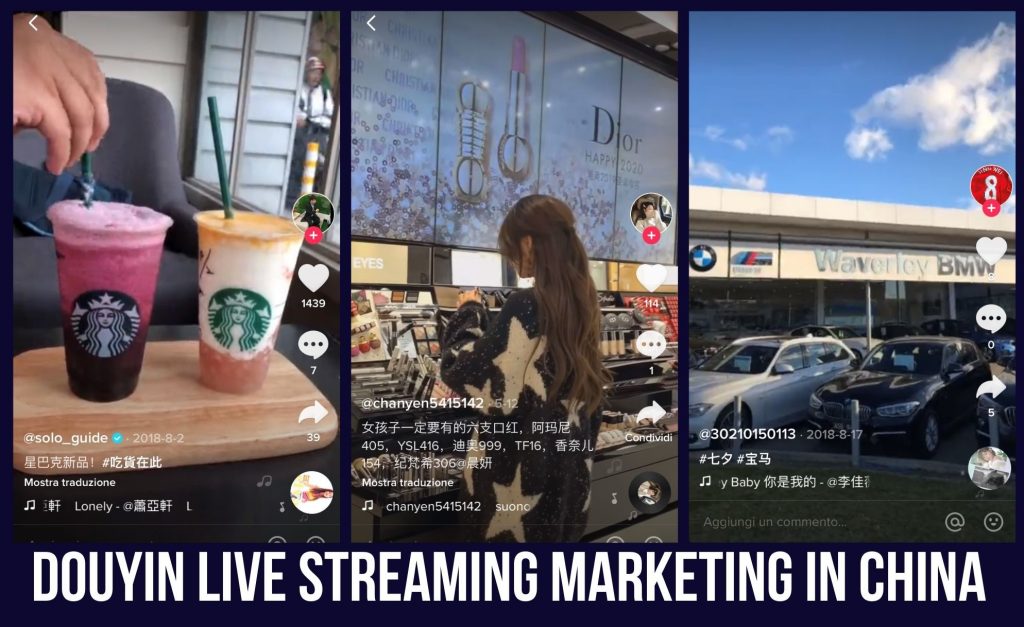
Douyin
Douyin (TikTok), the short-video social platform developed by Bytedance, has become one of the most popular mobile apps in the world, especially in China. 75% of users of this platform are Millennials and Gen Z, generations born between 1982 and 2003 (15-36 years), and mainly coming from first and second-tier cities. This category represents China’s new spending force as they don’t hesitate to satisfy their pleasures.
Douyin is the best tool to present a product to younger generations. Therefore, a business account in Douyin should exploit the link between customers’ daily life and its product, design a dramatic scene to present their relationship, and release the magic of the product.

Douyin has often proven to be a strategy for international brands in China. Its linear and direct communication, in fact, captures users and holds them in front of the screen longer than other platforms.
One of its peculiarities is the possibility of launching challenges, internal challenges to the app that invite users to join and respond by publishing new content. Often it is the brands that launch these challenges, being mentioned in millions of fans posts within a few hours.
Kuaishou: the main competitor of Douyin
Kuaishou, with about 300 daily active users, is one of the best-known short video apps in China. It is interesting to note that about 80% of its users are very young born after 1990, mostly residents in second and third-tier cities, and spend an average of 60 minutes a day on the app.
Lately, Kuaishou has expanded his interest in e-commerce too. According to data released by the company, 19 million users have made money using Kuaishou channels. We are talking about short video e-commerce and live streaming. Kuaishou connects directly to e-commerce platforms such as Taobao, Pinduoduo, and JD.

Much of Kuaishou’s success has been achieved thanks to the collaboration with CCTV which has given the short video app the opportunity to broadcast the annual, and very popular, New Year’s gala exclusively. The partnership with CCTV has allowed Kuaishou to reach a large number of users in a short time.
The popularity of Kuaishou among the public is purely given by the high content proposed and the potential profit that can arise. Sellers get the attention of users through short videos and then profit from advertising on their accounts.
In addition, sellers can capitalize directly via live streaming. This also makes it easier to turn the attention of many highly active consumers to themselves. Through live streaming, on the one hand, consumers can get closer to the product. On the other hand, sellers can show the characteristics of the different products marketed during the live stream.
Live-streaming and short videos on Douyin and Kuaishou are also the source of information for young people
Short videos have been selected as a platform to make a statement by numerous mainstream media. CCTV News and People’s Daily, two mainstream media, rank among the top five broadcasts of Douyin, from which it can be inferred that in the prevention of this pandemic, the interaction between mainstream media and short video enables users to gain access to the most timely and authoritative information through short videos and live-streaming.
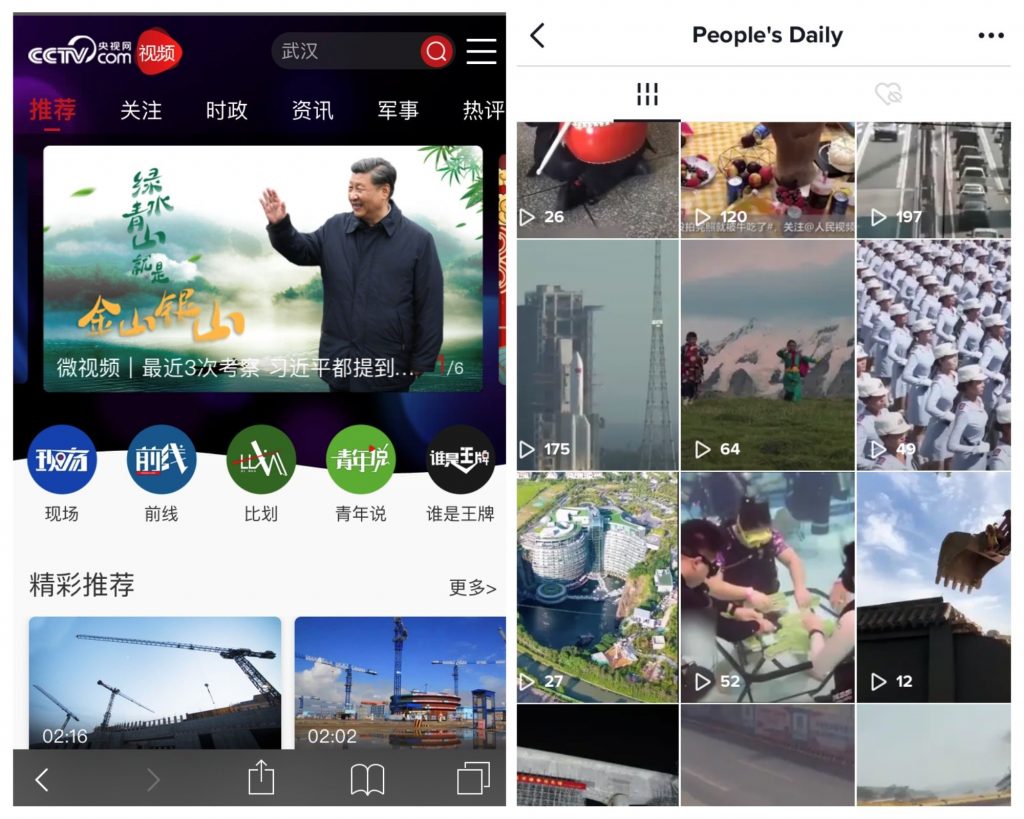
News clips, latest announcements, and recorded videos about citizens buying groceries, masks, or showing support to the medical staff from People’s Daily, Hubei Daily and China Central Television (CCTV) are filling the platform.
In this context, the information barriers between mainstream official platforms and short video transmission have been lowered to a certain extent.
Live Streaming in China: a way to express creativity
A digital shift has been created by COVID-19 among creative people, and more users are allowed to be creators through the medium of short video applications. With the emergence of various creative and distributed technologies, users try to re-contextualize the cultural products they consume and create.
For example, the video “my grandfather doesn’t want me anymore” has been streamed more than 10 million times as of around January 25. During the Spring Festival, the grandson has turned away from the house, with masks and gifts thrown out of the window. Despite the entertaining atmosphere created by these contents, the consciousness of participation and consensus of all viewers have been inspired.

Chinese social media users are having fun with live-streaming
As millions of Chinese people are stuck at home during the coronavirus outbreak, nightclubs across the country are keeping them entertained by holding “cloud raves” online.
Clubbers have been tuning into video platforms like Douyin and participating in them virtually.
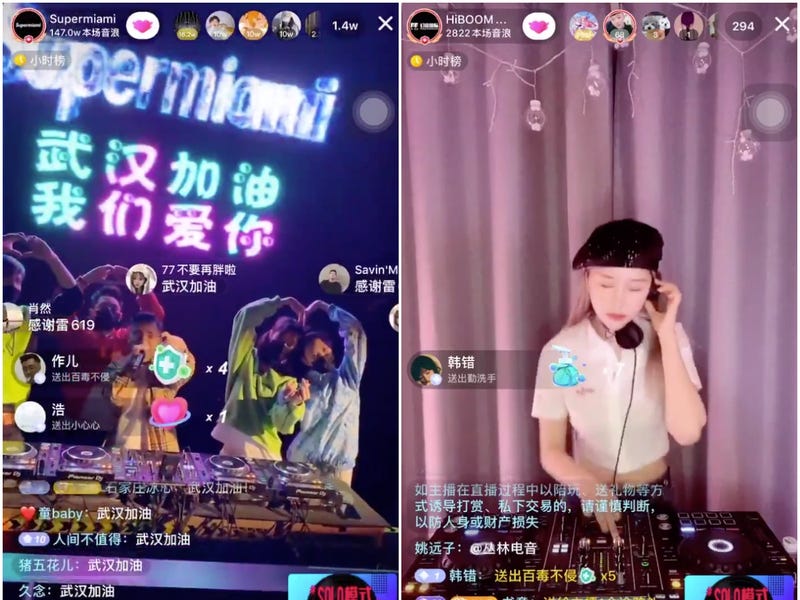
Some DJs performed live, while others pre-recorded their performances for later broadcast on Douyin’s life, and some ravers even posted videos of themselves dancing to the music at home. These cloud raves have been extremely successful, with millions of viewers tuning in to some of these live streams.
They can also be incredibly lucrative for the clubs. In a Livestream that gained 71,000 views, Shanghai club TAXX earned $104,000 in tips from online viewers paying through the app.
Other Chinese companies, such as Alibaba, have now organized “no meeting concerts” where singers and bands can broadcast their practice matches on Taobao live. Digital disruption is already happening, and it’s getting people’s attention.
Live streaming and e-commerce in China: a Bromance?
If in the West live streaming is preferred for entertainment purposes, in China it is also exploited a lot in terms of online sales. Hence the happy marriage between live streaming and e-commerce, the so-called live-commerce.
While watching a live stream, Chinese users can inquire about a product and buy it immediately, without ever changing the App. This real-time purchase is promoted by the “See now, buy now” concept used by many brands to increase sales.

For example, a recent Adidas live stream featuring this slogan was used to promote the latest limited-edition sneakers in China. The brand came to have 2.23 million views in 10 hours and to invoice 200 million Renminbi in impromptu purchases.
However, live streaming is not a tool to be exploited only for the fashion and beauty categories. Given its enormous expansion, it must also be integrated into its marketing strategy for the other market sectors. For example, other growing sectors are those of home furnishings and fresh food products.
Wanna get yourself started with Live streaming in China?
According to data released by the China Internet Network Information Center (CNNIC), as of the end of 2021, the number of viewers in the country has reached 703.4 million, an increase of 163 million from the end of 2018, accounting for 68.2% of the total number of Internet users.
E-commerce live streaming is a great opportunity for brands to promote their products to the Chinese audience. It’s especially true to foreign products and brands, as consumers can see better and trust the company after seeing a live stream with their favorite influencer. It’s a tool of 2022 and it’s definitely not going anywhere, so it’s best to use the opportunity to generate sales and raise brand awareness in the Chinese market.

We are a China marketing agency with more than 10 years of experience. We worked with over 600 brands from different sectors and we have the experience and know-how you need in China. We collaborate with many top influencers and live streamers in the Chinese market and we can help you select the ones most suitable for your brand.
Apart from live-streaming, we also offer many different services, such as market research, web design, localization, branding, e-reputation, Baidu SEO, social media accounts set-up, online reputation management, influencer marketing, and many more.
Check some of our case studies:

We invite you to leave us a comment or contact us to discuss your next project in China. We offer a free discovery consultation with our expert, that will learn about your needs and advise you on the best strategy for your sector in China. Let’s keep in touch!






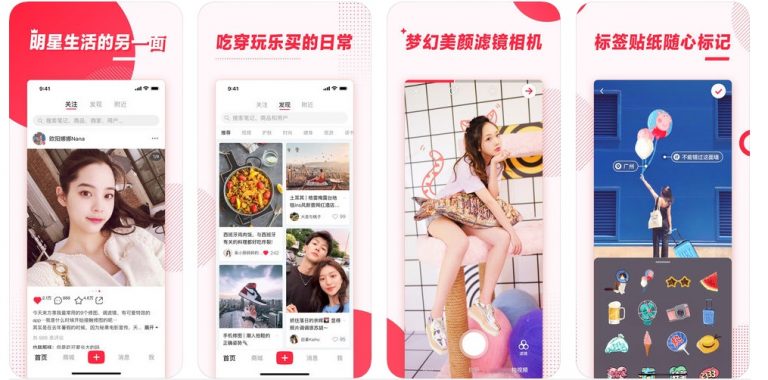
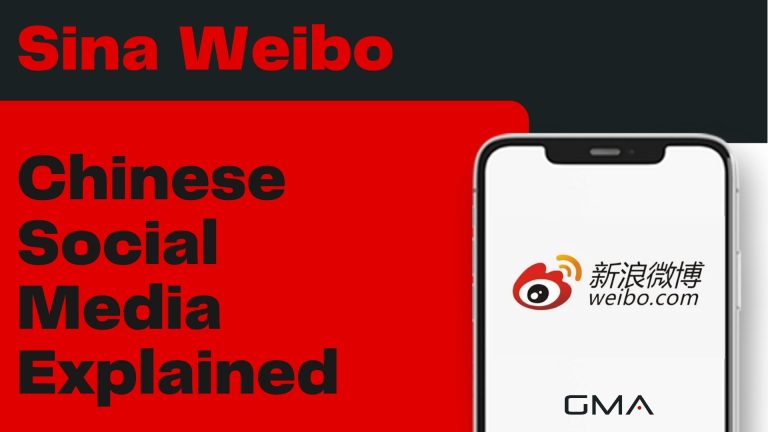
A 5 stars article , congrats
China on Saturday established a mechanism allowing it to restrict the activities of foreign companies the day after Washington announced the ban on downloading TikTok and WeChat from Sunday, further escalation in the standoff with Beijing over the comes out of both applications.
China’s list of “untrusted entities” – whose names of targeted foreign companies have not been made public – includes potential sanctions ranging from fines to restriction of activities or entry of equipment and personnel into China.